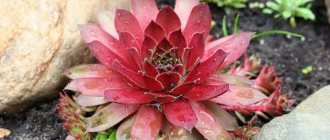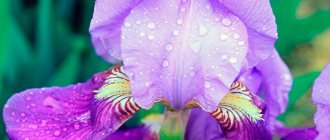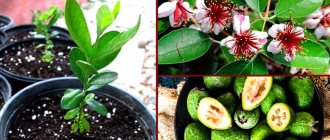Young, popularly called stone rose, is an unpretentious plant that is grown both in the garden and in the apartment. It needs some space and sunlight. Care rules include watering, fertilizing and replanting. Knowing the propagation technology, you can create attractive compositions from several specimens planted in one pot.
The flower is widely used in landscape design. It looks especially impressive on alpine slides, on the banks of reservoirs and waterfalls. When planting, it is important to consider combinations with other crops. Its hardiness and ease of propagation make it popular in various regions.
Description of the stone rose
Molodilo belongs to the Tolstyankov family. This is a succulent evergreen plant, which is popularly called the stone rose for its resemblance to a delicate flower. The scientific name is Sempervivum, which means “always alive” in Latin. This is explained by the fact that this succulent can survive in the most difficult conditions: on various soils and without water. Sockets remain fresh even after long postal shipments.
In its natural environment it grows on the outskirts of forests, rocky and dry areas. In the wild, it can be found in Asia, Northern and Eastern Europe, and the Caucasus. Thanks to its exotic appearance and hardiness, the young plant received many other names: velvet rose, tenacious, hare cabbage. There is a plant very similar to it - echeveria, which is often confused with it.
The stone rose is a rosette in the form of a ball with a diameter of 1 to 15 cm. Fleshy leaves are attached in a spiral to a short stem, which is covered with small glandular fibers. The leaf plate is elongated, pointed at the ends, with small cilia along its edge.
The surface may be waxy or covered with fluff. Thanks to the pubescence, the juveniles capture droplets of water, which helps them stay without moisture for a long time and survive in arid areas. The leaves have different colors: green, pink, red, silver, brown. Erect stems have no branches. Children are located on the elongated side shoots.
The stone rose blooms in mid-summer. Bisexual, star-shaped flowers are collected in paniculate or corymbose inflorescences. Located on a thick, fleshy peduncle growing from the center of the rosette. They can be yellow, white, red, purple and pink and have a pleasant aroma.
Juvenile has an interesting feature - the rosette blooms only once in its life after reaching the age of three for 2-2.5 months. When it fades, it dies and new shoots grow in its place.
The root system recovers quickly, so the plant can easily tolerate replanting. Withstands dry and frosty weather well. About 50 varieties of juveniles are known. The most popular ones are shown in the table.
| View | Description | Photo |
| Roofing | The plant has long been popular in Europe. It was previously used as a roofing material, which is why it got its name. The rosette is spherical, slightly flattened, reaching a height of 8 cm, a diameter of 20 cm. Pointed green leaves have red-burgundy tips. Blooms in mid to late summer season. Pink or reddish inflorescences | |
| Wulfena | Its natural habitat is the Alps. It grows at an altitude of up to 2700 m. The rosettes are 4-5 cm in diameter. The shiny green leaves have cilia along the edges and have a reddish tint at the base. The shoots are hard and elongated, with children located at the ends. On peduncles growing up to 25 cm, there are bright yellow flowers with a burgundy spot at the base. | |
| Limestone | One of the most beautiful varieties. It is distinguished by thinner, pointed leaves of a gray-green or bluish-green hue with brown or black tips. Rosettes reach 8 cm in diameter. A few flowers have a pink tint. | |
| Offspring | Grows on sandy soil in pine forests of Eastern and Northern Europe. The rosettes are in the form of a ball, reaching 5-6 cm in diameter, formed from light green leaves with a red edging and cilia along the edge. Flowering occurs in mid to late summer. Inflorescences are yellow or green. Used as a medicinal plant for heart failure and wound healing | |
| Russian | It grows in the wild in eastern Russia, Asia Minor and the Balkans. Elongated, pointed green leaves form rosettes with a diameter of 5-6 cm. Peduncles, covered with fluff, reach a height of 35 cm. Yellow flowers are collected in corymbose-shaped inflorescences | |
| Cobwebby | Rosettes up to 4 cm in diameter are covered with fluff, reminiscent of a cobweb. This feature gives the variety its name. The plant grows in the Caucasus. The green leaves have reddish-burgundy tips. Blooms with purple flowers. When grown in the garden for the winter, the rose must be placed on a loggia or balcony | |
| Marble | Leaves with white edges have greenish and pinkish streaks. With the onset of cold weather, some varieties turn red. Adult plants are smooth, while young ones are covered with light fluff. |
Beliefs about saxifrage
According to one of the legends in Scandinavia, rejuvenation was the plant of the god Thor. It was often planted on the roofs of houses . People believed that this would protect the house from lightning, the ruler of which was Thor. This is where one of the names of the plant came from: rejuvenated roofing sempervivum tectorum .
In Egypt, it was believed that the plant came from the seed of the god Amun. The young man was also credited with masculine strength due to the similarity of its flower to the male organ. And in England they believed that if saxifrage bloomed in the house of an unmarried girl , then she would soon get married.
According to other legends, tincture from the plant improves vision and hearing; girls rubbed its juice for blush. Some believed that if you carry a socket with you, you will not be bitten by a scorpion .
Choosing a location and landing rules
Juvenile does not require special conditions; the main thing for it is to find a sunny place without an excess of moisture. From the rays of the sun, the roses have a rich color, but grow to a medium size. If they are placed in the shade, they turn pale, lose their decorative effect, but become larger. There are varieties that, with a slight darkening, take on a more colorful appearance.
For growing in open ground, loose and breathable soil is suitable. There must be good drainage so that water does not linger in the soil. Fertility does not matter; the flower will grow on soil poor in nutrients, but will be small in size. Before planting, the area must be prepared, which will make maintenance easier. It is cleaned of weed rhizomes. To do this, it is better to use a pitchfork. You can simply loosen the ground without digging. Sand and fine gravel are added to it.
To plant the young, they dig holes corresponding to the size of the long taproots. Then the rhizomes are placed in the holes, the flower is pressed to the surface. Some varieties have short adventitious roots. In this case, they are simply pressed against loose soil. Planted plants should be watered so that they take root faster. Then moisturize little by little.
The planting pattern depends on the variety of sempervivum: some grow gigantic, while others have small rosettes. At first, the young ones can be planted densely after 5-10 cm, and when they grow up, they can be transplanted. The second option is to make the distance larger, and pour sand between the plants and lay out pebbles.
What hurts, who harms
The main disease of saxifrage is rot, which occurs due to excess moisture - the main enemy of the flower. Major pests include birds, worms and beetle larvae . If rot is detected, remove the affected areas and reduce watering - the main cause of rot.
If the plants were damaged by birds (crows, magpies, jackdaws), simply bury the flower torn out by the bird back. To prevent flying pests from causing damage to the flower, place a scarecrow in your garden . Larvae are more difficult to deal with. Because they are not visible. House flowers have no pests.
Outdoor care
Juveniles almost do not need watering. In summer, moisten the soil once every two weeks in case of dry weather. Water the plants at the roots so that water does not get into the outlet, as the leaves may begin to rot. To avoid negative consequences, it is better to water the soil nearby, the roots will take the required amount of moisture.
It is not necessary to feed sempervivum, since fertilizers, especially organic matter, harm it. Excess nutrients affect the color of the leaves, the flower loses its decorative effect. Fertilizing can be applied during the growing season. Special fertilizers for cacti are suitable. In the spring, before planting, nitrogen-containing preparations are added to the ground. The addition of ammonium nitrate at the rate of 7-8 grams per 1 square meter promotes plant growth.
After the rains have passed, the soil needs to be loosened to provide air access to the roots. Regular weeding is required until dense turf is formed. Weeds are removed carefully so as not to harm the root system. When the plants completely fill the flowerbed or alpine hill, weeds will grow less.
After weeding, the beds with sempervivums are shaded, removing the cover in cloudy weather. They are not afraid of the shadows, but can get burned if there is a sudden change in lighting. Therefore, when selecting flowers adjacent to succulents, you need to give preference to low-growing ones so that they do not create unnecessary shadow.
Although young plants are frost-resistant plants and feel good under snow cover, it is better to cover the flower for the winter, especially if it is not yet strong after transplantation. For these purposes, pine needles and fallen leaves are used. Individual specimens are covered with plastic bottles.
Planting a plant
Many people think: since the young plant looks so fancy, planting and caring for it definitely takes a lot of time. And they are wrong. Those who have managed to get acquainted with the plant note its extraordinary unpretentiousness. To grow this perennial in open ground, create the following microclimate:
- place – sunny;
- the soil is better infertile, sandy, well permeable to water.
Juvenile prefers the same soils as cacti.
If these conditions are met, after planting you can practically forget about care. In other circumstances, to reproduce the young on your site, you will need to make a little more effort.
Attention! Juveniles take root less well on heavy, clayey soils; they do not like excess moisture or excess fertilizer.
The plant has a poorly developed root system, so there is no need to make large holes when planting. Make the distance between large rosettes about 15 cm, between miniature ones - 5 cm. After this, watering. If you plant juveniles not in open ground, but in a window, add drainage to the bottom of the pot. You can add sand or sawdust to the soil. The main condition that makes growing juveniles successful is the same - a well-lit place.
Home care
When grown on a windowsill, the plant feels great if it is provided with good lighting. You need to care for them in the same way as cacti. You can take any soil, it is important that it is breathable and loose. It is advisable to add sawdust and sand. Pots must have drainage holes. When planting, a drainage layer of expanded clay, pebbles or small pebbles is also placed at the bottom.
At home, juveniles are watered very rarely and little by little. If overwatered, the root system may begin to rot. Spraying in hot weather is not recommended, as drops from the sun's rays can leave burns on the leaf surface. It is also not worth wiping the sockets, as they are covered with a protective film.
Juveniles reproduce poorly in an apartment - they produce few children and rarely bloom. This situation can be changed by increasing lighting, lowering the temperature in winter, stopping watering for two months, giving the plant a rest.
The healing properties of rejuvenation
The medicinal properties of the plant have been undeservedly forgotten! And quarry leaves can be used in folk medicine to prepare decoctions, ointments, and infusions. The flower has the following medicinal effects:
- anesthetic,
- disinfectant,
- healing,
- calming,
- anti-inflammatory.
Interestingly, no contraindications have been identified for taking plant-based medications. Although an allergic reaction to the components of the flower is possible, overdoses should be avoided if taken orally. Pregnant and nursing mothers should not use infusions from the plant .
It is not recommended to give to children under three years of age. Important! There are no toxic components in the composition of saxifrage.
Medicines from rejuvenate are used for the following diseases:
- stomach ulcer, gastritis,
- women's pain,
- skin problems,
- heat.
- inflammation in the oral cavity ,
- cardiovascular problems,
- epilepsy,
- diseases of the eyes and ears.
To prepare ointments, you need to take the leaves of the flower, crush them and apply the pulp to the sore spot : a wound, callus, wart, blister from an insect bite.
Juvenile juice whitens the skin and removes freckles and age spots. A decoction of the leaves is used to rinse the mouth if there are wounds or taken orally to treat ulcers. The decoction is also used to remove worms and treat hemorrhoids.
Advice! Despite the abundance of beneficial properties, you should use medicines from the plant with caution, and be sure to consult your doctor before use!
Reproduction was young with rosettes
The main way to obtain new specimens of stone roses is through children. It allows you to grow proven varieties. Most flower species reproduce independently and very quickly. You don't even need to make an effort to do this. But you can speed up this process. The young will develop faster in a sunny place.
Reproduction with the help of children is divided into two groups:
- Varieties that produce mustaches.
- Species without long shoots.
In the first group, each whisker has a small rosette at the end. To reproduce young of this type, you need to quickly root the baby. If there is free space near the mother plant, loosen the soil nearby, press the rosette tightly and sprinkle the tendril with soil. After this, carefully water it. New sempervivums take root and grow quickly. In the future, the grown rosettes can be planted. They should be replanted together with the shoots.
If the mother flowers are located too close to each other and there is no room for rooting, allow the rosette at the end of the tendril to grow and separate it from the old plant. At the same time, make sure that the main part of the process remains with the baby. This is important because they will become tap roots in the future. If they are not left, the young will grow more slowly. The seedlings are planted for growing, while the tendrils are deepened.
Interesting! An unusual species is Rosa Rugosa. Be sure to read it.
In the second, beardless type, the young reproduce directly in the axils of the leaves. It seems that the stone rose is completely covered with small rosettes. As they grow up, they fall to the ground. Growing in the lower axils, young crops take root next to the mother plant.
Such varieties are propagated by collecting children and planting them in beds, which are moistened before planting. When the water seeps in, the surface is loosened to a depth of 5 cm. It is advisable to plant the sempervivums close to each other, and when they grow up, transplant them to a permanent place. This group of stone roses does not have taproots, so when transplanting they are simply pressed to the ground. Thin roots grow very quickly.
The first time after planting, the young ones are watered frequently, but at the same time they only moisten the soil.
Features of cultivation
Thanks to its excellent unpretentiousness and survival rate, this plant can be successfully grown even by novice gardeners, since it requires virtually no care
Usually, it is enough to simply provide it with the necessary conditions (a site in the sun and well-drained soil), the bush will do the rest for the grower himself . The optimal temperature for growing juveniles is the range from 20 to 25 degrees Celsius.
Errors in caring for a plant usually manifest themselves in excessive “indulgence” of it. Abundant watering and fertilizing, as well as too fertile soil, are not the best option for juveniles. Quite the opposite: the plant will not absorb excess nutrients and water, but their abundance can be taken advantage of by potential pests: weeds and fungi.
For young plants, we recommend the “Spartan” method of care - succulents themselves are capable of not only sufficiently supplying themselves with nutrients, but can even make reserves in the soft tissues of their leaves.
Landing
Young rosettes are planted with a small piece of stolon
The choice of soil for a plant is quite specific. It needs rocky or sandy areas. It is allowed to plant juveniles in alumina soils and even plant them in chernozems, but there should be small pebbles in the root layer to ensure good drainage.
Expanded clay, small crushed stone, pebbles, gravel with a fraction of 4-5 mm, etc. will also be suitable drainage filler. Actually, preparing the place where the juveniles need to be planted should always include the creation of a drainage layer.
As noted earlier, the area for juveniles should be located on the sunny side. Plants can be planted at any time during the warm season - a stone rose can take root well in a very short time.
It is also advisable to drain the free space around the flower with small stones. It’s even better to remove the top layer of soil altogether and fill in shallow drainage instead to a height of 1-2 cm.
Watering
Water treatments for succulents
A special feature of succulents is the ability to accumulate liquid reserves, so frequent or abundant watering is not required for a stone rose. Moreover, too frequent watering is harmful for the plant, and if the drainage system does not fulfill its role, the plant can be destroyed in a very short time.
It is recommended to water the stone rose flower only before replanting, or in conditions of severe drought. In this case, the frequency of watering should not exceed once every two weeks, and in no case should moisture fall on the leaves.
Feeding
Agricola is one of the simple solutions for feeding young
Until the age of three, the young do not need additional feeding. In the future, in order to maintain the juvenile’s former beauty, it should be fed regularly. Adult plants can be fed once every 2-3 weeks, and then only do this during the growing season. Typically, fertilizers for cacti are used with their concentration halved.
For juveniles, root feeding is used. If you use fertilizing with spraying of foliage, or if the concentration of fertilizers is exceeded, the leaves of the rosettes begin to stretch and disintegrate. If a similar phenomenon is observed, fertilizing should be stopped and not used next season.
Rest period
In winter, succulents enter a dormant period.
At this time, it is recommended to bring heat-loving varieties from the garden indoors and place them in a cool place. It is recommended to keep them here until mid-spring. The frequency of watering is reduced to once every 1-2 months. In this case, you should not allow moisture to get on the leaves of the rosette.
Plants in the garden do not need special care. If they are frost-resistant, they can withstand wintering well under a layer of snow. In the event of a snowless winter, it is recommended to cover individual rosettes with plastic bottles, and cover the continuous covers of the juveniles with agrofibre.
The shelter can also be made from other materials. Coniferous spruce branches or straw are ideal for this purpose. They should be carefully poured on top of the carpet of rosettes in a layer 10-15 cm thick. In case of windy weather, you will also need agrofibre or plastic film to cover the straw on top.
Reproduction
Reproduction of young ones using leaf cuttings
This process occurs independently, without the help of a gardener. The only thing that needs to be done is to plant young shoots, cutting off the stolons going from the mother plants to the children, digging up and replanting the latter. Actually, propagation by shoots is the simplest and most intuitive way of propagating young ones.
If you need to obtain a large amount of planting material, propagation by cuttings is used. To do this, take a large rosette and divide it into separate petals. They are planted in a small container with moist cactus substrate. Cuttings take root and take root fairly quickly, but it is recommended not to replant them immediately after root formation. Only after small rosettes have formed should they be planted in a permanent place.
If there is no special substrate, you can make it yourself by taking garden soil and river sand in equal proportions. Theoretically, you can use any available soil, as long as the mixture is loose in consistency.
In some cases, seed propagation is also used. Every year by September, the seeds of the young ripen. The fruits are multi-seeded leaflets. From 100 to 250 seeds are formed on each peduncle.
They can be used for planting plants. The seeds do not need to be pre-dried; just plant them in open ground or in a pot in mid-autumn and young plants will sprout next spring.
Most varieties of juveniles are capable of propagation by self-sowing; to avoid this, the flower stalks should be pruned immediately after the end of their flowering.
Diseases and pests rejuvenated
The common starling can cause damage not only to the cherry harvest, but also to the succulent leaves of the young
Like all representatives of the plant kingdom, juveniles are a food source for some animal species. Sometimes they can cause significant damage to plantings, since the delicate and soft tissues of the plant have practically no protective functions.
The primary pests of juveniles are birds of the corvid and starling families. Crows, jays and rooks love to feast on the succulent rosettes and buds of the plant. The root system of the juvenile is of interest to the larvae of the cockchafer.
You can fight birds using various repellers or scarecrows. Saving a plant from larvae is much more difficult. Often the only effective remedy is to transplant the plants to a new location and dig up the soil while simultaneously destroying the larvae.
May beetle larvae are capable of eating the roots of almost all types of garden plants.
It is best, as soon as traces of the cockchafer’s activity are noticed, to immediately transplant the largest rosettes to a new location or temporarily transfer them to pots.
Excessive air humidity can lead to the formation of rot on the rosettes and peduncles of the plant . The lower part of the plant rots first. At first, the rosettes lose their rich color, then crack and turn brown. Over time, the rot spreads to neighboring outlets.
Disease control does not involve the use of chemicals or sprayers. It is necessary to get rid of damaged sockets as soon as possible and remove them from the planting. In this case, you will have to remove neighboring, possibly even healthy shoots and rosettes.
Seed method of obtaining new young
Reproduction is possible using seeds. The disadvantage of this method is that there is no guarantee that it will grow the same plant as the mother plant. Sempervivums obtained by seed are often of the same type, green in color, and lose their varietal characteristics.
The process of obtaining young from seeds is long, but uncomplicated. Sowing is carried out in winter, spring, and summer directly in the garden bed or in small containers. It’s easier to grow at home, since you don’t need to fight weeds and it’s more convenient to monitor watering.
Sow seeds to a depth of 1 mm. In order for them to germinate, they need to be constantly moistened and the temperature maintained at +20 degrees. The young have small seedlings, so you should be more careful when weeding. It is necessary to water carefully so that the stream of water does not wash the germinating seeds and small seedlings from the soil.
Shoots appear after 3-5 days.
You have to tinker with seedlings a lot. In the first year, the rosettes are very small. In the second, they grow larger and give birth to children. Only in the third year does the young become a full-fledged flower.
Watering
Like any other succulent, the rock rose does not need frequent watering or misting because it is able to store moisture and essential nutrients in its succulent leaves. Light watering may be necessary only before transplanting. Only in very dry summers, with a long absence of rain, can the young be watered once every 2 weeks, while directing the water under the roots and avoiding getting on the leaves. When growing stone roses at home, in winter watering is reduced to once every 2 months. With excess moisture, the lower leaves first become limp and then dry out.
The beauty of sempervivum flowers
The stone rose is popular due to the decorative nature of its leaves, but it also blooms beautifully. True, each rosette blooms only once in its life. During flowering, it gradually dries out and eventually dies. In its place, children grow up and rejuvenation occurs. When purchasing new species, you should purchase young specimens, since young ones that are more than 3 years old bloom.
The tenacious flowers are graceful, beautiful, varied in color and shape. They bloom for a long time - almost all summer. The testes also have a spectacular appearance. The fruit consists of 8 to 20 multi-seeded leaflets covered with glandular fibers.
Large adult sempervivums may not bloom. But you can see the flowering of young plants. The fact is that stone roses begin to bloom due to unfavorable conditions and stress - if they become cramped, have nowhere to grow, with strong shading.
By planting young plants densely, you can cause increased flowering.
Name confusion
Echeveria - a plant similar to young
The name “stone rose” refers to another plant of the Crassulaceae family – Echeveria. these related species are indeed similar as both are succulents and look almost identical.
But, unlike juveniles, which mainly grow in the mountains of Eurasia, echeveria is a resident of Central America. It does not tolerate frost at all, since it is adapted to life in the arid sands of the Chihuahuan Desert.
In addition, this wild plant is much larger in size than the young one. Succulent leaves can contain large amounts of water and nutrients that have refreshing properties.
It is very difficult to grow echeveria even in apartment conditions, since providing it with the necessary temperature and air humidity is quite problematic.
Diseases and pests rejuvenated
The plant has high immunity, so they most often get sick due to improper care. There are also insects that can cause great harm to them. The most common health problems:
- Rotting of roots and rosettes. The reason is waterlogging of the soil. You can detect that putrefactive processes have begun by looking at the lower leaves. Sometimes the young becomes transparent and then turns brown. The affected parts are cut out, the flower is disinfected, and then replanted in new soil. If the disease has affected the root system, the plant should be replanted so that rot does not affect healthy specimens.
- Weeds, growing between the rosettes, take nutrients and moisture from the soil from the succulent. If there is too much weed, it will shade the young plants, which will negatively affect their decorative appearance. Therefore, weeding is done regularly.
- A dangerous pest for sempervivums is the cockchafer, or rather its larvae (Article about the larvae of the chafer). They eat leaves, making long passages through them. If damaged, the flower is transplanted into another flowerbed, and the soil where it grew is treated with chemicals against insects.
- Birds also harm the young: magpies, jays, crows. They feast on stems and leaves. They are fought with the help of special preparations or plants are planted that repel birds.
If you properly care for a stone rose, you can grow huge rosettes or get a carpet of small flowers in your flowerbed. Among the stones of the rakalia or alpine hill, the juvenile looks very impressive.
Application in landscape design
A path of various types of young plants in a flowerbed
The simplest use of juveniles is to create cover areas, as well as to decorate the borders of paths or borders. This is a traditional use of the plant, used in landscape design since the times of the Roman Empire.
Juvenile has a wide palette of colors, so you can even create carpets from plants or lawns in the form of paintings with complex elements. Naturally, maintaining such a picture unchanged will require serious time investment, but the process is worth it.
A carpet with a complex pattern of various rock rose hybrids
In nature, most species of juveniles grow in mountainous areas, so they will be an ideal filler for any alpine slide or rock garden. Moreover, given that the plant practically does not require soil, individual stone rose bushes can be placed in large crevices of stones in your garden.
The use of young plants in rock garden design
An interesting option for using plants for decorative purposes is creating a florarium. This is the name of a terrarium or aquarium in which, instead of animals, there are only plants.
To some extent, the florarium is the pinnacle of minimalist landscape design - it reproduces a corner of nature on the smallest scale, which can be placed, for example, on a desk.
Typical florarium with juveniles
Juveniles are best suited as a plant for a florarium, since they require high-quality soil and some special maintenance conditions. However, one of the conditions still has to be met - a sufficient amount of light. But, as a rule, there are no problems with this, since the design of the florarium involves installing it in a sunny place or having constant lighting in the form of fluorescent (or LED) lamps. You can also use phytolamps with them.
Even in the conditions of a florarium, young plants are able to actively grow. To avoid filling the entire volume of the miniature ecosystem with it, the population should be thinned out from time to time and daughter rosettes should be planted.
Flowering period
Juvenile blooms with variegated, bright flowers with pointed petals. The size and color depend on the plant variety and can be red, yellow, pink, white, purple. However, the plant is valued for its decorative rosettes, so it is used in landscape design regardless of flowering.
The young ones are blooming.
Plants that have reached 2-3 years of age bloom. Each rosette blooms once. Then seeds are formed, and the rosette gradually dries out and dies. The flowering period lasts throughout the summer. Sometimes young plants may not bloom for many years - plants need stress (temperature changes or changes in other conditions) to set buds. The dense and compact planting of the rosettes ensures flowering even in young specimens.











